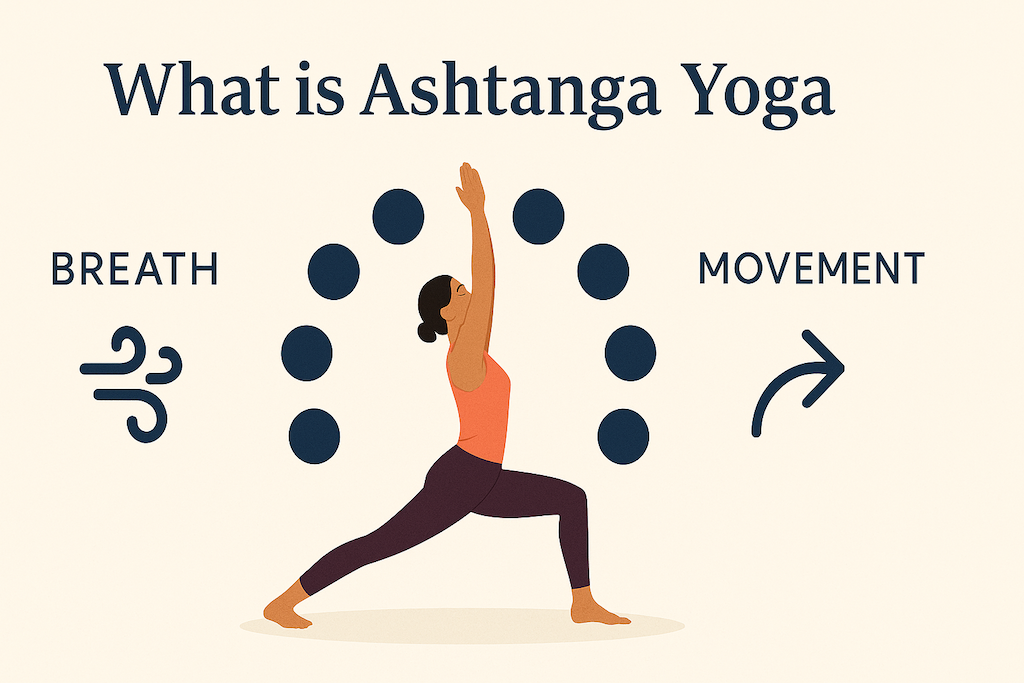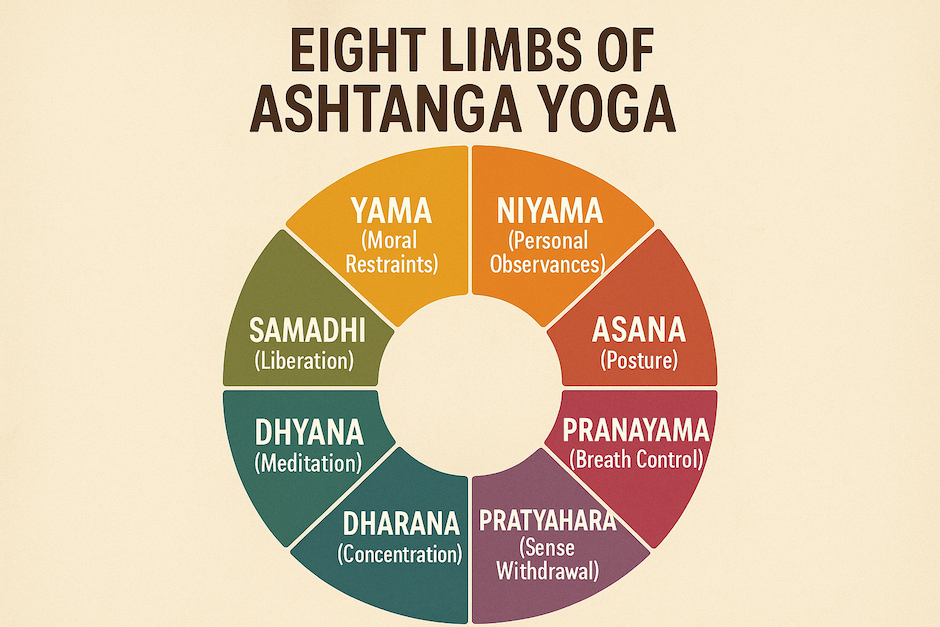

Ashtanga Yoga is a traditional, dynamic style of yoga that synchronizes breath with a progressive series of postures, creating internal heat and intense focus. Unlike other yoga styles that vary sequences, Ashtanga follows six set series, with practitioners mastering each before advancing.
The various sequences of Ashtanga Yoga, starting with the Primary Series, are designed to detoxify the body, build strength and flexibility, and cultivate clarity and focus. So, whether you're a beginner seeking structure or an experienced practitioner, Ashtanga Yoga offers a path to deeper awareness, transformation, and holistic well-being.
Continue reading to discover what Ashtanga Yoga is, how it works, its origins and philosophy, and what sets it apart.
The word "Ashtanga" is derived from two Sanskrit words: "Ashta," meaning eight, and "Anga," meaning limbs. Together, they refer to the Eight Limbs of Yoga described in the ancient Yoga Sutras of Patanjali—a guide to living a meaningful and spiritually fulfilling life. Sujit Tiwari, a certified yoga instructor at MyYogaTeacher, explains, “Ashtanga Yoga is a dynamic and energetic practice that is relevant and widely practiced today because of its holistic benefits. By synchronizing breath with movement, it offers both physical strength and mental clarity.”
In practice, Ashtanga Yoga is a structured and holistic system that blends movement, breath, discipline, and yogic philosophy. Each session follows a fixed sequence of postures performed in a specific order, where every movement is linked to the breath. This consistent structure doesn’t just help you master poses, but also develop focus, discipline, and self-awareness. The repetition allows for deeper internal observation, revealing subtle shifts in physical sensations, energy levels, and emotional states.
This is the essence of Ashtanga Yoga: a practice that favors depth over variety, guiding the practitioner inward through breath-led movement. The practice of Ashtanga Yoga lays down a methodical and introspective approach that emphasizes lasting change through consistent effort, mindful repetition, and dedicated self-inquiry.
The history of Ashtanga Yoga begins with the foundational texts of Indian philosophy. In the Yoga Sutras (written around 200 BCE), Patanjali outlines the Eight Limbs of Yoga—ethical and meditative principles designed to lead one toward liberation (moksha).
While the physical postures associated with modern Ashtanga Yoga are not detailed in the Sutras, the philosophical framework they provide deeply influences the practice. These Eight Limbs form the backbone of Ashtanga Yoga, integrating moral conduct, physical discipline, breath control, sensory withdrawal, concentration, meditation, and ultimately, spiritual realization.
The system of Ashtanga Yoga practiced today was shaped by Sri K. Pattabhi Jois, a dedicated student of the legendary yoga master T. Krishnamacharya in Mysore, India. In the early 20th century, Jois drew upon ancient texts, including the Yoga Korunta, to develop a methodical, breath-synchronized sequence of postures, now known as the Ashtanga Vinyasa system.
In 1948, he established the Ashtanga Yoga Research Institute in Mysore, where he began teaching students from around the world. His approach emphasized tradition, discipline, and a self-paced style of learning known as the Mysore method, where students progress through the sequence under a teacher’s guidance.
Today, Ashtanga Yoga is practiced globally, but its heart remains in India. Its rich legacy makes it not just a method of movement but a sacred pathway that continues to inspire transformation
Want to practice Ashtanga Yoga in its most authentic form? Book a free 1-on-1 session with an Indian yoga coach today!

To truly understand Ashtanga Yoga, we must look beyond its physical poses and explore its philosophical foundation: the Eight Limbs of Yoga. First outlined by Patanjali in the Yoga Sutras, these guiding principles form a step-by-step roadmap for personal growth and spiritual transformation.
Here’s what each limb represents:
Learn more about the Eight Limbs of Ashtanga Yoga here!
The practice of Ashtanga Yoga is guided by very precise principles that not only distinguish Ashtanga from other forms of yoga but also support its goal of integrating body, breath, and mind. These include:
The vinyasa system in Ashtanga follows a specific breath count for each transition and posture. Every transition and pose is carefully choreographed to either an inhale or an exhale, creating a rhythm that feels both meditative and physically dynamic. This coordination is a deliberate technique designed to build internal heat, increase focus, and detoxify the body through sweat.
A key element of the vinyasa method is Ujjayi breathing—a controlled breath that produces a soft, oceanic sound in the throat. This technique helps regulate the length and quality of each inhale and exhale, maintaining a steady rhythm throughout the practice.
The concept of Tristhana refers to the three focal points that anchor the practitioner’s attention during practice: Asana (posture), Pranayama (breath), and Drishti (gaze). Together, these elements create a deeply focused and inward-looking experience.
Tristhana brings the physical, respiratory, and mental aspects of the practice into alignment. By consistently training attention on these three anchors, the practitioner develops a steady and meditative awareness, which is essential for progressing toward deeper states of concentration and presence.
One of the most defining features of Ashtanga Yoga is its structured progression through a fixed sequence of postures. This method is divided into six series, each building on the previous in terms of physical difficulty, energetic refinement, and internal awareness.
Every practitioner, regardless of experience level, begins with the Primary Series and only moves forward under the guidance of a qualified instructor. This progressive system ensures safety, respect for the body’s pace, and a deepening of practice that is both physical and spiritual.

Here’s how Ashtanga compares to some of the most common modern yoga forms:
Ashtanga stands apart for those who crave not only physical transformation but mental discipline and spiritual alignment.
Experience this for yourself by booking this free group class on Ashtanga Yoga!

By committing to this disciplined, breath-centered practice, practitioners experience a range of benefits that extend well beyond the mat.
With consistent practice, Ashtanga Yoga helps with:
Some mental and emotional benefits include:
Beyond the physical and mental dimensions, Ashtanga Yoga nurtures a deeper spiritual awareness. The benefits include:
The benefits of Ashtanga Yoga accumulate over time, reshaping how you move, think, and engage with the world. With the right guidance, this practice becomes a tool for holistic transformation.
Book a free 1-on-1 session to experience these benefits.
Starting your Ashtanga Yoga practice requires a willingness to show up with patience and curiosity, and mastering it requires consistency. Whether you're new to yoga or deepening a long-time practice, here are some tips to get you started:
If you've explored other yoga styles or already have a steady practice, Ashtanga offers layers of refinement:
Ready to take the next step? Begin your Ashtanga journey today with authentic Indian coaching at MyYogaTeacher. Book a 1-on-1 session today!
Ashtanga is considered one of the more physically and mentally demanding styles due to its fixed sequences, fast pace, and emphasis on discipline. However, it's accessible to all levels with proper modifications and guidance.
Ashtanga Yoga is based on the eight-limbed path outlined in Patanjali’s Yoga Sutras. It combines breath-synchronized movement (vinyasa), posture (asana), and internal focus to promote physical strength, mental clarity, and spiritual growth.
Ashtanga follows a fixed sequence of postures and a strict breath count, while Vinyasa is more flexible and creative in its flow. Ashtanga emphasizes consistency and tradition; Vinyasa allows variety and teacher-led innovation.
Ashtanga stands out for its structure, discipline, and integration of breath, movement, and philosophy. Unlike many styles that vary by class, Ashtanga follows a set sequence designed to deepen focus and facilitate internal transformation.

Receive personalized guidance tailored to your unique fitness goals, live with a dedicated coach—no credit card required.